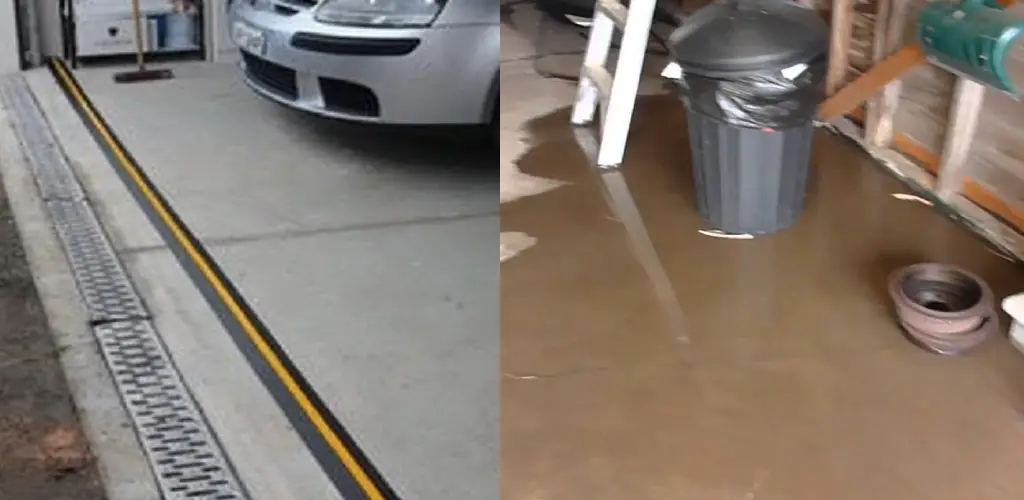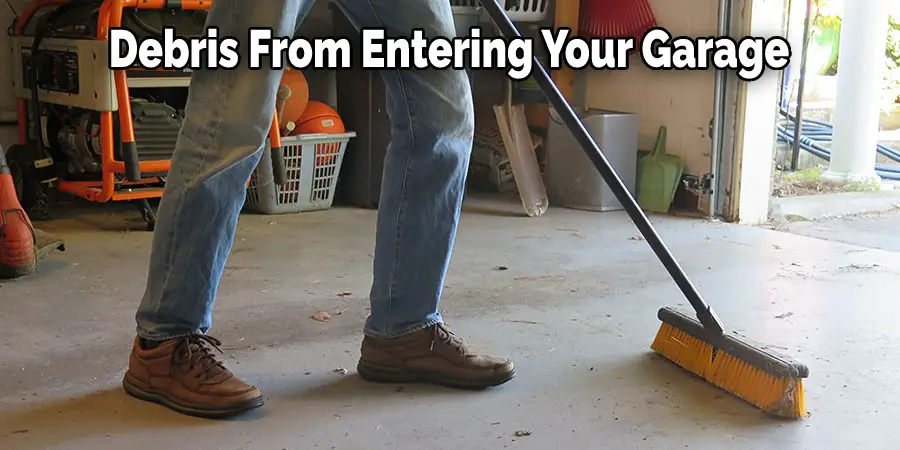Do you live in an area that is prone to flooding? If so, it’s important to take steps to protect your garage from flooding. By taking a few simple precautions, you can help ensure that your garage stays dry and protected during a flood. Here are some tips on how to keep garage from flooding.

Summary: Check for leaks, fix any cracks or holes, and keep your gutters and downspouts clear of debris. Install a sump pump to remove water in case of flooding, and direct downspouts away from your garage. Regularly maintain your garage and inspect the surrounding area for any potential drainage issues.
Why It’s Important to Keep Garage from Flooding?
A garage is one of the most versatile rooms in a house. It can be used for storage, a workshop, or even a home office. However, a garage can also be susceptible to flooding.
Heavy rains can overwhelm gutters and downspouts, causing water to seep through cracks in the foundation. Once inside, the water can damage belongings and create unsafe conditions.
How to Keep Garage from Flooding Step by Step Guide
Step 1: Inspect and Repair the Garage Structure
Begin by inspecting the garage structure for any cracks or gaps in the walls, floor, and ceiling. Pay special attention to the garage door and windows, as these are common entry points for water. If you find any cracks or gaps, repair them using a suitable sealant or caulking material. Ensure that the garage door is properly sealed when closed, and consider installing weatherstripping around the door and windows to prevent water infiltration.
Step 2: Install Gutters and Downspouts
If your garage does not already have gutters and downspouts, consider installing them to direct water away from the structure. Gutters collect rainwater from the roof and channel it to downspouts, which carry the water safely away from the garage’s foundation. Ensure that the downspouts are positioned at least 5-6 feet away from the garage and that they direct water to a sloped area, allowing it to flow away from the building.
Step 3: Grade the Land Around the Garage
The land surrounding your garage should slope away from the structure to prevent water from pooling around the foundation. If the land is not adequately graded, regrade the area so that it slopes away from the garage at a minimum of 6 inches over the first 10 feet. This will help prevent water from seeping into the garage through the foundation and floor.
Step 4: Install French Drains
If water continues to pool around your garage despite proper grading, consider installing French drains to redirect water away from the structure. French drains consist of a perforated pipe buried in a gravel-filled trench that collects water and channels it away from the garage. Consult a professional to design and install an effective French drain system for your specific situation.
Step 5: Install a Sump Pump
In areas prone to flooding or if your garage is built below grade, installing a sump pump can help prevent water from entering the garage. A sump pump collects water in a sump pit and pumps it outside and away from the structure. Choose a suitable sump pump for your garage size and water infiltration issues, and consult a professional for installation if necessary.
Step 6: Waterproof the Garage Walls and Floor
Applying a waterproofing sealer or coating to the garage walls and floor can help protect against water infiltration. Choose a waterproofing product specifically designed for concrete or masonry surfaces and follow the manufacturer’s instructions for application. Keep in mind that waterproofing products may require regular reapplication to maintain their effectiveness.
Step 7: Maintain Gutters, Downspouts, and Drains
Regular maintenance of your gutters, downspouts, and drains is essential to prevent water from entering your garage. Clean gutters and downspouts at least twice a year, removing any leaves, debris, or sediment that may have accumulated. Inspect and clean French drains and other drainage systems regularly to ensure they remain clear and functional.
Step 8: Store Valuables on Shelves or Raised Platforms
To protect your belongings from potential water damage, store items on shelves, raised platforms, or in waterproof containers. Avoid storing valuable or water-sensitive items directly on the garage floor, as they may be damaged in the event of a flood.
Step 9: Install Flood Vents
Flood vents can help equalize water pressure on your garage walls during a flood, preventing structural damage. These vents allow water to flow in and out of the garage, reducing the risk of wall collapse due to hydrostatic pressure. Install flood vents according to your local building codes and the guidelines provided by the Federal Emergency Management Agency (FEMA).
Step 10: Purchase Flood Insurance
If you live in a flood-prone area, consider purchasing flood insurance to protect your property and belongings from potential flood damage. Standard homeowner’s insurance policies typically do not cover flooding, so it’s essential to obtain separate flood insurance through the National Flood Insurance Program (NFIP) or a private insurer. Make sure to discuss your coverage needs with an insurance agent to ensure you have adequate protection.
Step 11: Monitor Weather Conditions
Stay informed about local weather conditions, particularly during heavy rainstorms or periods of potential flooding. Sign up for weather alerts from your local government or a trusted weather app to receive notifications about potential flood threats. This will allow you to take preventive measures, such as sandbagging your garage or moving valuables to a safer location if necessary.
Step 12: Install Flood Barriers
In areas prone to flooding, consider installing temporary or permanent flood barriers to protect your garage from rising water levels. Temporary barriers, such as sandbags or water-filled tubes, can be placed around the garage’s perimeter during a flood event. Permanent flood barriers, such as floodwalls or levees, can be constructed to provide long-term protection against floodwaters. Consult a professional to determine the most suitable flood barrier solution for your specific situation.
Step 13: Check the Garage’s Ventilation System
A well-ventilated garage can help reduce humidity levels and prevent mold and mildew growth, which can result from water infiltration. Ensure that your garage has adequate ventilation, such as through vents, windows, or exhaust fans, to maintain a dry environment.
Step 14: Create an Emergency Preparedness Plan
Develop an emergency preparedness plan for your household, which includes steps to take in the event of a flood. This plan should include:
- A list of important phone numbers, such as local emergency services and your insurance agent
- An evacuation plan, including a designated meeting place for your family members
- A list of essential items to take with you during an evacuation, such as important documents, medications, and a change of clothes
- Instructions on how to shut off utilities, such as gas, water, and electricity
By being prepared, you can better protect your property and ensure the safety of your family during a flood event.
By following these steps, you can effectively reduce the risk of your garage flooding and minimize the potential damage caused by water infiltration. Regular maintenance, proper drainage, and the use of waterproofing measures can help keep your garage dry and protected from the elements. In addition, staying informed about local weather conditions and having an emergency preparedness plan in place can help you respond effectively to potential flood threats, safeguarding your property and belongings.
How Do I Stop Water From Coming Under My Garage Door?
Most homeowners have experienced the frustrating sight of water seeping under their garage door and pooling on the floor. This is unsightly, but it can also lead to serious damage to your home if left unchecked. So, what can you do to prevent water from coming under your garage door?
First, make sure that your gutters and downspouts are clear of debris. This will ensure that rainwater can flow freely away from your home. Second, seal any cracks or gaps in your garage door using caulk or weatherstripping. These simple measures will go a long way toward keeping your garage dry and your home safe from water damage.
How Do You Seal the Bottom of A Garage Wall?
In order to prevent water, pests, and debris from entering your garage, it is important to seal the bottom of the wall. There are a few different ways to do this.
One option is to install a layer of rigid foam insulation. This will create an effective barrier against moisture and pests. You will also need to add a vapor barrier to prevent water vapor from entering the garage.
Another option is to install a gravel or stone barrier. This will allow water to drain away from the garage, preventing it from pooling at the base of the wall.
Whichever method you choose, make sure to seal all gaps and cracks around the edges of the barrier to create a complete seal.

Frequently Asked Question
Does Sealing Concrete Stop Moisture?
There is no one-size-fits-all answer to this question, as the effectiveness of concrete sealers in preventing moisture depends on various factors, such as the type of sealant used, the porosity of the concrete, and the climate conditions.
However, sealing concrete can help reduce the moisture that penetrates the surface and may even provide some waterproofing protection.
Is It Good to Put Plastic Under Concrete?
Yes, it is a good idea to put plastic sheeting under concrete. The plastic will help prevent moisture from seeping through the concrete and causing it to crack.
Is Thompson’s Water Seal Good for Concrete?
Thompson’s Water Seal is a water-repelling sealant that can be used to protect concrete from flooding. It can be applied to the concrete’s surface and will help keep moisture out.
Conclusion
As you can see, you can do a few things to help keep your garage from flooding. You can help protect your home and belongings from water damage by following these tips. Have any other tips to share? Let us know in the comments below! Thanks for reading our post about how to keep garage from flooding.
You can check it out to Store Fishing Rods in Garage
